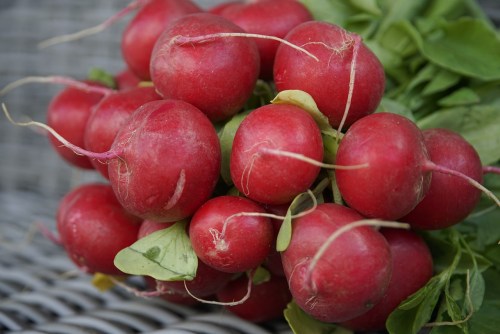Radishes don't always get the love they deserve, but these little root vegetables contain lots of flavor. You can shred them and add them to salads, soups, and more. Radishes are also incredibly easy to grow, perfect for gardeners who are just finding their footing outdoors or for gardeners with young children interested in gardening.
These unique root veggies are a great first vegetable for children, as the ease of growing them and their brilliantly red color make them entertaining and rewarding. If you want to add these root vegetables to your fall or spring garden, we’ll tell you everything you need to know about how to grow radishes.
What are the different varieties of radishes?
French Breakfast is an old heritage variety that's known for its small, cylindrical radishes that are bright red with white tips. This variety is mild and crisp, excellent for a simple bread and butter breakfast or a more complicated soup. Its small size and speedy growth make this variety especially popular for container gardens.
If you’re looking for a classic radish experience, you can’t go wrong with Cherry Belle. This variety produces round, red radishes with a crisp texture and a mild, sweet flavor. On the other hand, if a classic experience is the last thing on your mind, then why not grow Golden Helios radishes? As the name suggests, they're a bright gold color, and, although there isn’t a significant difference in flavor, the stunning color makes it a show stopper. The radish greens are equally appealing, with a pretty streak of purple that highlights them in salads or sandwiches.
Black Spanish radishes are a unique treat, but they take some patience to grow. They’re slower to mature than other radish varieties, but their appearance and flavor make them worth the wait. They have black exteriors and white centers. This variety’s flavor has been described as slightly peppery, which makes it an interesting addition to a wide range of dishes.
Planting radishes
Radishes can be planted throughout spring and fall, and multiple crops of radishes can be grown in a single growing season. However, you should avoid growing radishes through the middle of summer, as they are sensitive to heat. Radishes can still be grown indoors in containers during summer, though. Hot weather causes radishes to bolt (produce flowers) extremely quickly, which renders the radish itself bitter and unpleasant.
You can start planting radishes four to six weeks before the last frost in spring or the first frost in fall. Some varieties are better suited for one season than the other, so be sure to familiarize yourself with the variety you’re growing.
Step 1: Choose a sunny planting spot, either with full sun or mostly sun with some shade. Radishes will grow in the shade, but they produce smaller radishes and larger leaves.
Step 2: Prepare soil that is loose and fairly rich. Sand can help loosen dense soil, while compost can improve the soil’s overall quality.
Step 3: Plant seeds half an inch to an inch deep, spacing them roughly 2 inches apart.

Watering radishes
Watering is important for radishes to grow properly. They need consistent moisture, but can still develop problems if left in standing water.
Step 1: Add a layer of mulch around your radishes.
Step 2: Water your radishes on a consistent schedule.
Step 3: If you can't check your garden daily, install drip irrigation to keep the soil at the right level of moisture.
Weeding radishes
Radishes aren’t often plagued by pests, but weeds can easily crowd radishes and outcompete them for resources, especially while the radishes are young.
Step 1: Make plans to regularly weed your radish crops.
Step 2: If you find yourself weeding your radish crops too much, consider using mulch as a weed suppressor.
Harvesting radishes
It’s best not to leave your radishes in the ground for too long past the point of maturity. Once they mature, they’ll have a few weeks of extra growth before they become tough and bitter. Some varieties are designed to avoid this process altogether or to at least lengthen the amount of time before they become unpleasant, but in general, it’s better to be safe than sorry.
Harvest times can vary between radish varieties, so knowing the kind of radish you’re growing is essential. The quickest maturing varieties tend to be ready after three or four weeks, while slower growing varieties take five to seven weeks.
Step 1: Keep an eye out for leaf growth. You can typically tell how quickly a variety is maturing by how quickly the leaves are growing.
Step 2: Then, dig up a single radish and use its maturity to gauge whether or not you should harvest the rest of your crop.
Step 3: After your harvest, trim and wash your radishes to store in the refrigerator.
Radishes are easy to grow, and they produce results quickly. If you’re looking to squeeze in an extra vegetable at the end of a growing season or want a vegetable that’s easy enough for anyone to grow, then why not give radishes a try? As a bonus, radish seeds store very well, so don’t worry if you change your mind after getting the seeds! They’ll still be there later for whenever you want them.
Editors' Recommendations
- Peonies can grow just about anywhere – here’s how to care for them
- The best (and worst) garlic companion plants
- The best (and worst) watermelon companion plants
- How to care for gardenia, a fragrant, heat-loving bloom
- How often should you water your grass seeds? Here’s what we know